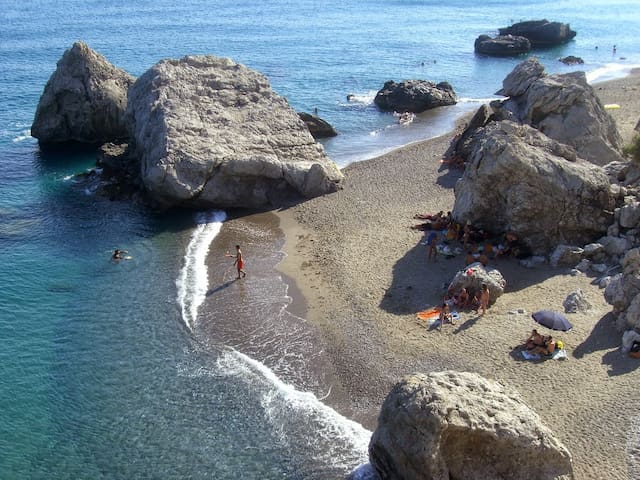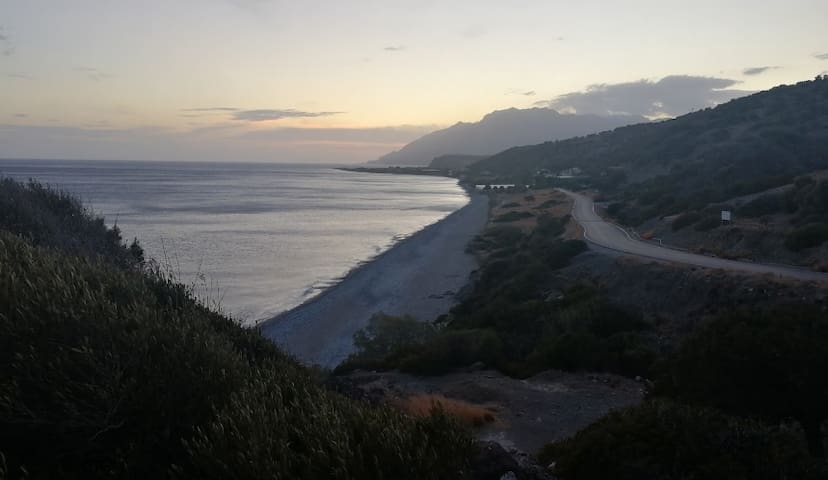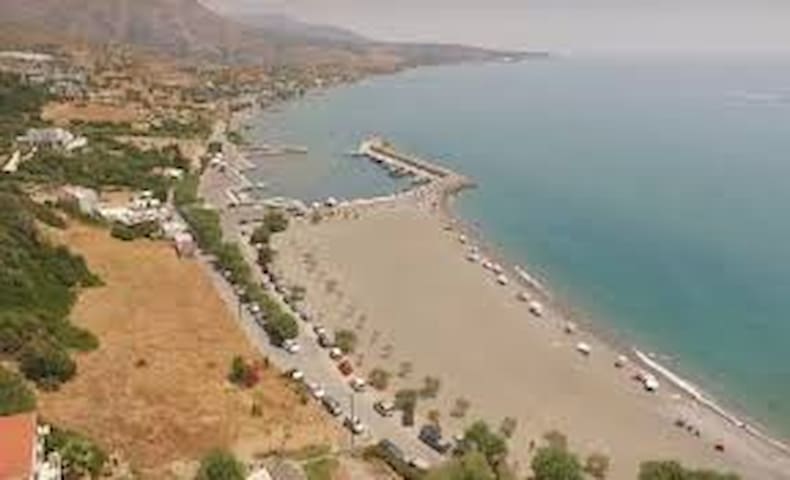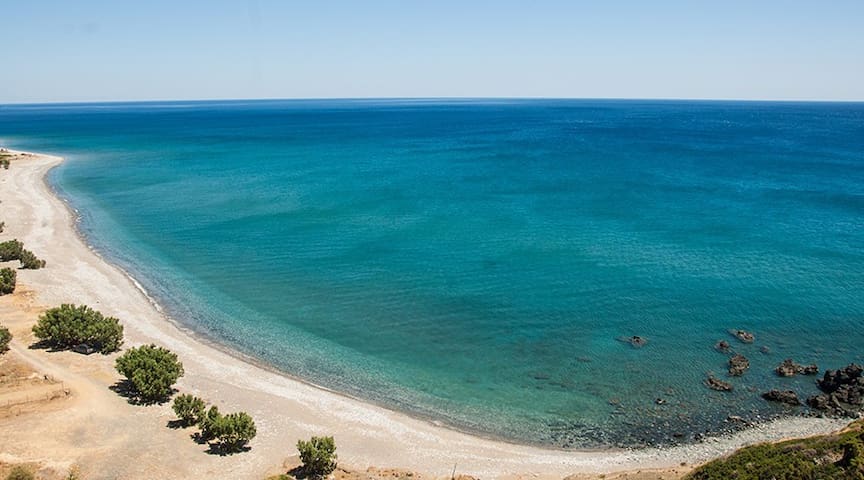Food Scene
Nikitas
Tavern Morning Star
ΚαστρίονTavernaCafe Faros
Vagia Café
ΚαστρίονTaverna Kriti
ΚαστρίονCasa di Pasta Christina
Taverna Jimmys
Τhe best coffee in keratokampos, with endless sea view!
11 il-persuni tal-post jissuġġerixxu
Aeriko Cafe
Τhe best coffee in keratokampos, with endless sea view!
beachcomber
Μαγατζές Κερατόκαμπος - Magatzes Keratokampos
Shopping
SUPER MARKET ΒΑΣΙΛΙΚΗ ΠΕΤΡΑΚΗ
Super Market Faistos
ΚαστρίονArt and Culture
The Gallery of Viannos is housed in a restored olive oil mill at Keratokampos. The vision of its founder Savvas Petrakis and the local cultural club " VIGLA" became a reality in 2008, when the gallery was inaugurated by the President of Greece.
It hosts more than 200 works of very famous Greek artists (Fasianos, Mitaras Parmakelis, Kessanlis, Tsoklis, Rokos etc.). The quality of the works of the Gallery and its position at the extreme end of the Cretan island, have classified that as the southernmostgallery of Europe.
Besides the exhibition, the Gallery has proceeded with its own editions, such as texts of Ioannis Kondylakis, one of the most famous authors originating from Viannos.
The Gallery of Viannos is housed in a restored olive oil mill at Keratokampos. The vision of its founder Savvas Petrakis and the local cultural club " VIGLA" became a reality in 2008, when the gallery was inaugurated by the President of Greece.
It hosts more than 200 works of very famous Greek artists (Fasianos, Mitaras Parmakelis, Kessanlis, Tsoklis, Rokos etc.). The quality of the works of the Gallery and its position at the extreme end of the Cretan island, have classified that as the southernmostgallery of Europe.
Besides the exhibition, the Gallery has proceeded with its own editions, such as texts of Ioannis Kondylakis, one of the most famous authors originating from Viannos.
6 il-persuni tal-post jissuġġerixxu
Viannos Gallery
The Gallery of Viannos is housed in a restored olive oil mill at Keratokampos. The vision of its founder Savvas Petrakis and the local cultural club " VIGLA" became a reality in 2008, when the gallery was inaugurated by the President of Greece.
It hosts more than 200 works of very famous Greek artists (Fasianos, Mitaras Parmakelis, Kessanlis, Tsoklis, Rokos etc.). The quality of the works of the Gallery and its position at the extreme end of the Cretan island, have classified that as the southernmostgallery of Europe.
Besides the exhibition, the Gallery has proceeded with its own editions, such as texts of Ioannis Kondylakis, one of the most famous authors originating from Viannos.
Theater "Kokolas"
Very nice atmosphere under stars. Unique musical concerts!
Public Beach
Skouros beach is a beautiful long sandy beach with fine sand and some rocks and pebbles, surrounded by tamarisk trees that give some shade.
Παραλία Αρμενόπετρα
The name Listis comes from a rocky area on the east side where there are several caves: according to the local residents a bandit (Listis) lived in one of the caves. The caves are easily accessible from the main road.
22 il-persuni tal-post jissuġġerixxu
Παραλία Ληστής
The name Listis comes from a rocky area on the east side where there are several caves: according to the local residents a bandit (Listis) lived in one of the caves. The caves are easily accessible from the main road.
Skouros beach is a beautiful long sandy beach with fine sand and some rocks and pebbles, surrounded by tamarisk trees that give some shade.
11 il-persuni tal-post jissuġġerixxu
Skoúros
Skouros beach is a beautiful long sandy beach with fine sand and some rocks and pebbles, surrounded by tamarisk trees that give some shade.
Παραλία Καμπουλά
Paralia Kastri
Paralia Dermatos
Hiking
A powerful Byzantine castle on the south coast of Crete atop a steep rock with excellent natural defensing position.
It was built after the 10th century and the reconquest of Crete by the Byzantines, i.e. during the second Byzantine period. It was not used by the Venetians after the 13th century.
The slopes of the hill are full of remains from the Mycenaean, Hellenistic and Byzantine periods. That means that a settlement existed there for many centuries; but not at the top of the hill. The top must have been used as a refuge and became a castle only after the 10th century.
The powerful fortification, the numerous buildings, the 5 cisterns (one of which was huge, 210m3) show that the fortress was designed to become an important stronghold.
One theory places at the long beach under this rock the point where the Saracens first landed when they conquered Crete in 824 AD.
So after the Byzantines came back, they decided to provide a better protection here.
Keraton or Vigla
A powerful Byzantine castle on the south coast of Crete atop a steep rock with excellent natural defensing position.
It was built after the 10th century and the reconquest of Crete by the Byzantines, i.e. during the second Byzantine period. It was not used by the Venetians after the 13th century.
The slopes of the hill are full of remains from the Mycenaean, Hellenistic and Byzantine periods. That means that a settlement existed there for many centuries; but not at the top of the hill. The top must have been used as a refuge and became a castle only after the 10th century.
The powerful fortification, the numerous buildings, the 5 cisterns (one of which was huge, 210m3) show that the fortress was designed to become an important stronghold.
One theory places at the long beach under this rock the point where the Saracens first landed when they conquered Crete in 824 AD.
So after the Byzantines came back, they decided to provide a better protection here.
Kératon
Keraton or Vigla
A powerful Byzantine castle on the south coast of Crete atop a steep rock with excellent natural defensing position.
It was built after the 10th century and the reconquest of Crete by the Byzantines, i.e. during the second Byzantine period. It was not used by the Venetians after the 13th century.
The slopes of the hill are full of remains from the Mycenaean, Hellenistic and Byzantine periods. That means that a settlement existed there for many centuries; but not at the top of the hill. The top must have been used as a refuge and became a castle only after the 10th century.
The powerful fortification, the numerous buildings, the 5 cisterns (one of which was huge, 210m3) show that the fortress was designed to become an important stronghold.
One theory places at the long beach under this rock the point where the Saracens first landed when they conquered Crete in 824 AD.
So after the Byzantines came back, they decided to provide a better protection here.







